Piccadilly Line
Piccadilly line map.


Piccadilly Line Overview
The Piccadilly Line is a line of the London Underground network which crosses the town of London from the north to the west. It connects the Heathrow Airport and the town of Uxbridge in the western part of the Greater London to Cockfosters, in the north, through the city centre of the English capital city. Around 220,000,000 passengers use the Piccadilly line. It serves 53 stations and has a total length of 44 miles. It is the Dark Blue Line on the Tube map.
London Piccadilly Line Service Status
Tourist attractions on the piccadilly line.
- Trent Park , a beautiful country park with its country house is located in front of Cockfosters tube station.
- The Emirates Stadium , home ground of Arsenal F.C is accessible from Finsbury Park , Arsenal and Holloway Road .
- The British Museum , which is the most visited museum of the United Kingdom, dedicated to culture and art, is served by both Russel Square and Holborn stations.
- Lincoln’s Inn Fields , the biggest and one of the most popular public squares in London, and Sir John Soane’s Museum , dedicated to the work of the famous English neo-classical architect, are located close to Holborn Underground station.
- Leicester Square , a popular green square famous for hosting events during the Chinese New Year, is accessible from Leicester Square station.
- Piccadilly Circus , the public square famous for its buildings with giant video and neon advertisements, is served, as its name indicates, by Piccadilly Circus tube station.
- Green Park , one of the Royal Parks of London, and Buckingham Palace , the London residence of the British Royal Family, are located at walking distance from Green Park station.
- Hyde Park , another Royal Park of London, stands, as its name suggests close to Hyde Park Corner Underground station.
- Harrods and Harvey Nichols , the 2 famous department stores are accessible from Knightsbridge tube station.
- The Natural History Museum , the Science Museum , the Victoria and Albert Museum , the world’s biggest design museum, the Royal Albert Hall , a beautiful concert hall located in front of Kensington Gardens and the Royal College of Music are served by South Kensington Underground station.
- Boston Manor , one of the ancient manors of Middlesex, and its park, are situated next to Boston Manor station.
Piccadilly Line stations
- Cockfosters is the northern terminus station of the Piccadilly Line. Travelcard Zone 5.
- Oakwood station is located in the area of Oakwood which gives it its name. Travelcard Zone 5. Wheelchair accessible.
- Southgate tube station is located in the suburban area of London which holds the same name. Travelcard Zone 4.
- Arnos Grove tube station is located, as its name indicates, in the area of Arnos Grove. The station building is listed Grade II*. Travelcard Zone 4.
- Bounds Green Underground station is located in the area which gives it its name. Travelcard Zone 3-4.
- Wood Green station is located in the popular residential area of Wood Green, as its name indicates. Travelcard Zone 3.
- Turnpike Lane tube station is located in Haringey, on the street of Turnpike Lane. Travelcard Zone 3.
- Manor House station is located in the district which holds the same name. Travelcard Zone 2-3.
- Finsbury Park is located at walking distance from the Emirates Stadium, home of Arsenal FC. Travelcard Zone 2.
- Arsenal is the closest Underground station from the Emirates Stadium, which is accessible from there too. Travelcard Zone 2.
- Holloway Road tube station is located in the district of Holloway. It is also very close to the Emirates Stadium. Travelcard Zone 2.
- Caledonian Road station also stands in Holloway, on the road which gives it its name. Travelcard Zone 2. Wheelchair accessible.
- King’s Cross St. Pancras station is one of the biggest interchange complexes in London. It is connected to both London King’s Cross and St. Pancras International railway stations. Travelcard Zone 1. Wheelchair accessible.
- Russell Square Underground station stands in Bloomsbury, on Bernard Street. It is located close to the British Museum. Travelcard Zone 1.
- Holborn tube station is located at the corner of Kingsway and High Holborn in Central London. Travelcard Zone 1.
- Covent Garden station stands at the corner of James Street and Long Acre, in the City of Westminster. Travelcard Zone 1.
- Leicester Square tube station is situated on Charing Cross Road, very close to the pedestrian square of the same name. Travelcard Zone 1.
- Piccadilly Circus station is located under Piccadilly Circus, whoch gives the name to the station and to the line. Travelcard Zone 1.
- Green Park Underground station is located very close to the Royal Park of London which holds the same name. It also serves Buckingham Palace. Travelcard Zone 1. Wheelchair accessible.
- Hyde Park Corner station, as its name indicates, stands at the southeastern corner of Hyde Park. Travelcard Zone 1.
- Knightsbridge is located in the shopping area which gives it its name, where stand both Harrods and Harvey Nichols department stores. Travelcard Zone 1.
- South Kensington tube station is situated in the district of Kensington. There are many important museums nearby. Travelcard Zone 1.
- Gloucester Road station stands at the corner of Gloucester Road and Cromwell Road, in Kensington. Travelcard Zone 1.
- Earl’s Court Underground station is located in the district which holds the same name. Travelcard Zone 1-2. Wheelchair accessible.
- Barons Court tube station is located in West Kensington. Travelcard Zone 2.
- Hammersmith station stands in the district which gives it its name. Travelcard Zone 2. Wheelchair accessible.
- Turnham Green Underground station is situated in the district of Chiswick, West London. Travelcard Zone 2-3.
- Acton Town station stands in the area of Acton, which gives it its name. Travelcard Zone 3. Wheelchair accessible.
- South Ealing tube station is located in the suburban district of Ealing. Travelcard Zone 3.
- Northfields station is situated in the residential area which holds the same name. Travelcard Zone 3.
- Boston Manor Underground station is located in the area of the Boston Manor, as its name indicates. Travelcard Zone 4.
- Osterley station stands in the suburban area of Osterley, which gives it its name. Travelcard Zone 4.
- Hounslow East is one of the 3 stations on the line located in the town of Hounslow. Travelcard Zone 4. Wheelchair accessible.
- Hounslow Central Underground station is also located in Hounslow. Travelcard Zone 4.
- Hounslow West is the third station situated in the town of Hounslow. Travelcard Zone 5. Wheelchair accessible.
- Hatton Cross tube station stands in the small residential area of Hatton. Travelcard Zone 5-6.
- Heathrow Terminal 4 station serves, as its name indicates, the terminal 4 of Heathrow Airport. Travelcard Zone 6. Wheelchair accessible.
- Heathrow Terminals 2 & 3 serves terminal 2 and 3 of Heathrow Airport. It previously also served terminal 1, now closed. Travelcard Zone 6. Wheelchair accessible.
- Heathrow Terminal 5 tube station is the southwestern terminus station of Piccadilly Line. It serves the terminal 5 of Heathrow Airport. Travelcard Zone 6. Wheelchair accessible.
- Ealing Common station is, as its name indicates, located in the area of Ealing Common. Travelcard Zone 3.
- North Ealing Underground station is situated in the London Borough of Ealing. Travelcard Zone 3.
- Park Royal tube station stands close to the industrial and business area of Park Royal, which gives its name to the station. Travelcard Zone 3.
- Alperton station, at its name suggests, is located in the area of Alperton. Travelcard Zone 4.
- Sudbury Town station is located in the suburban area which gives it its name. Travelcard Zone 4. Wheelchair accessible.
- Sudbury Hill is also located in Sudbury. Travelcard Zone 4.
- South Harrow tube station is situated in the area which holds the same name. Travelcard Zone 5.
- Rayners Lane Underground station stands in the district of Rayners Lane. Travelcard Zone 5.
- Eastcote station is located in the suburban area which gives it its name. Travelcard Zone 5.
- Ruislip Manor tube station is situated in the area which shares the same name. Travelcard Zone 6.
- Ruislip Underground station is located in the town of Ruislip. Travelcard Zone 6.
- Ickenham station stands in the area which holds the same name. Travelcard Zone 6.
- Hillingdon tube station is located in the suburban area which gives it its name. Travelcard Zone 6. Wheelchair accessible.
- Uxbridge station is the western terminus station of the Uxbridge branch of the Piccadilly Line. Travelcard Zone 6. Wheelchair accessible.
The Piccadilly Line serves different important transportation sites
- Heathrow Airport is served by 3 different tube station on Piccadilly Line. Terminals 2 and 3 are served by the station which holds the same name, terminals 4 and 5 are served by 2 additional stations.
- London King’s Cross is one of the 2 railway stations served by King’s Cross St. Pancras tube station. You can there a train to the northern part of England, and to Scotland.
- St Pancras International is the other station connected to King’s Cross St. Pancras Underground station. You can travel there to Paris or Brussels with the Eurostar.
The Piccadilly Line is connected to the following London Underground lines
- Victoria Tube Line at Finsbury Park.
- Circle Line , Hammersmith & City Line , Metropolitan Line , Northern Tube Line and Victoria Line at King’s Cross St. Pancras.
- Central Line at Holborn.
- Northern Tube Line at Leicester Square.
- Bakerloo Tube Line at Piccadilly Circus.
- Jubilee Tube Line and Victoria Line at Green Park.
- Circle Tube Line and District Line at South Kensington and Gloucester Road.
- District Line at Earl’s Court, Barons Court, Hammersmith, Turnham Green, Acton Town and Ealing Common.
- Metropolitan Tube Line at Rayners Lane, Eastcote, Ruislip Manor, Ruislip, Ickenham, Hillingdon and Uxbridge.
Ticket Price
Piccadilly line timetable.
The Piccadilly line runs every day of the week including saturdays, sundays and holidays.
First Service
The first service leaves Cockfosters Underground station at 5:09 from Monday to Saturday , and at 7:00 on Sundays , Heathrow Terminal 5 Underground station at 5:23 from Monday to Saturday , and at 6:07 on Sundays , Heathrow Terminal 4 Underground station at 5:02 from Monday to Saturday , and at 5:46 on Sundays and Uxbridge at 6:20 from Monday to Friday and at 8:43 on Saturdays and Sundays .
Last Service
The last service leaves Cockfosters Underground station at 23:54 from Monday to Saturday , at 23:00 on Sundays , Heathrow Terminal 5 Underground station at 23:42 from Monday to Saturday , and at 23:25 on Sundays , Heathrow Terminal 4 Underground station at 23:35 from Monday to Saturday , and at 22:37 on Sundays and Uxbridge at 23:04 from Monday to Saturday and at 22:04 on Sundays .
You can find the full Piccadilly line timetable on the TFL website.
TfL Piccadilly underground
Tfl piccadilly underground stop list and next departures.
The TfL Piccadilly - Piccadilly underground serves {count_of_stops} underground stops in the London area departing from {first_stop} and ending at {last_stop}. Scroll down to see upcoming Piccadilly underground times at each stop and the next scheduled Piccadilly underground times will be displayed. The full Piccadilly underground schedule as well as real-time departures (if available) can be found in the app .
The TfL Piccadilly - Piccadilly underground route map is shown above. The route map shows you an overview of all the stops served by the TfL Piccadilly underground to help you plan your trip on TfL. Opening the app will allow you to see more detailed information about the route on a map including stop specific alerts, such as stops that have been closed or moved. You can also see the location of vehicles in real-time on the route map so you know when the Piccadilly underground is approaching your stop.
TfL Piccadilly underground Service Alerts
Open the app to see more information about any active disruptions that may impact the Piccadilly underground schedule, such as detours, moved stops, trip cancellations, major delays, or other service changes to the underground route. The app also allows you to subscribe to receive notifications for any service alert issued by TfL so that you can plan your trip around any active or future disruptions.
TfL Piccadilly underground FAQ
What time does the next tfl piccadilly underground depart from {first_stop}.
The next Piccadilly underground leaves {first_stop} at {first_stop_first_time}, and arrives at {last_stop} at {last_stop_first_time}. The total trip time for the next TfL Piccadilly underground is {number_of_minutes} minutes.
Is the TfL Piccadilly underground running on time, early or late?
You can track your underground on a map, monitor real-time updates, and see adjustments to the TfL Piccadilly schedule by downloading the app .
When does the next TfL Piccadilly underground arrive?
You can see the next TfL Piccadilly underground times in the app as well as future departure times for the Piccadilly underground.
How many underground stops are there for the TfL Piccadilly underground?
There are {count_of_stops} stops on the TfL Piccadilly underground.
Is the TfL Piccadilly underground usually crowded?
You can find real-time information on TfL Piccadilly underground crowding levels in the app (available in select cities or on select trips). You can also see predictions on how crowded the underground will be when it gets to your underground stop.
Is the TfL Piccadilly underground currently running?
Find out the current status for the TfL Piccadilly underground in the app .
What is the closest TfL Piccadilly underground stop to me?
Open the app to see your location on a map and find the closest Piccadilly underground stop to where you are.
Other TfL underground schedules, routes and maps
- Bakerloo Bakerloo
- Central Central
- Circle Circle
- District District
- Hammersmith & City Hammersmith & City
- Jubilee Jubilee
- Metropolitan Metropolitan
- Northern Northern
- Victoria Victoria
- Waterloo & City Waterloo & City
Other transit modes in London area
Never miss your underground again. download transit..
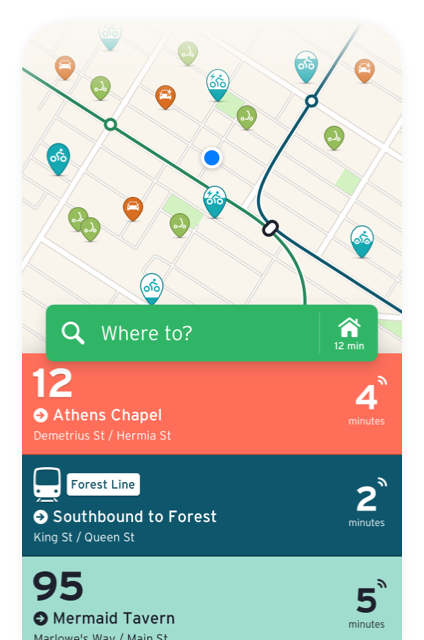
Times, Timetables, Maps, Info, Stuff.

Piccadilly Line Stations & Tube Map
Piccadilly line tube map, a list of piccadilly line stations.
This is a list of all Piccadilly Line stations from Cockfosters to Uxbridge.
Cockfosters Oakwood Southgate Arnos Grove Bounds Green Wood Green Turnpike Lane Manor House Finsbury Park Arsenal Holloway Road Caledonian Road King’s Cross St. Pancras Russell Square Holborn Covent Garden Leicester Square Piccadilly Circus Green Park Hyde Park Corner Knightsbridge South Kensington Gloucester Road Earl’s Court Barons Court Hammersmith Turnham Green Acton Town Ealing Common North Ealing Royal Park Alperton Sudbury Town Sudbury Hill South Harrow Rayners Lane Eastcote Ruislip Manor Ruislip Ickenham Hillingdon Uxbridge
This is a list of all Piccadilly Line stations from Cockfosters to Heathrow Terminal 4.
Cockfosters Oakwood Southgate Arnos Grove Bounds Green Wood Green Turnpike Lane Manor House Finsbury Park Arsenal Holloway Road Caledonian Road King’s Cross St. Pancras Russell Square Holborn Covent Garden Leicester Square Piccadilly Circus Green Park Hyde Park Corner Knightsbridge South Kensington Gloucester Road Earl’s Court Barons Court Hammersmith Turnham Green Acton Town South Ealing Northfields Boston Manor Osterley Hounslow East Hounslow Central Hounslow West Hatton Cross Heathrow Terminals 1,2,3 Heathrow Terminal 4
Navigating the Iconic London Underground: Unveiling the Wonders of the Piccadilly Line
Beneath the bustling streets of London lies an intricate network of underground railways, transporting millions of commuters and tourists every day. Amongst these lines, the Piccadilly Line stands out as one of the most iconic and historic routes. Spanning across the capital, it weaves through the city, connecting vibrant neighbourhoods, historical landmarks, and cultural hotspots. Join us as we embark on a captivating journey along the Piccadilly Line, discovering its rich history, architectural wonders, and unrivalled connectivity.
The Birth of an Icon: Origins and Evolution
The Piccadilly Line, a testament to London’s engineering prowess, had its humble beginnings in the early 20th century. Officially opening in 1906, the line initially connected Finsbury Park and Hammersmith. Over the years, the line expanded its reach, evolving into the extensive route we know today.
Its distinctive name is derived from the Piccadilly area, famous for its fashionable ties to the textile trade during the 17th century. The Piccadilly Line not only connects these historical roots but also extends its branches to other significant parts of London, including Heathrow Airport, making it a crucial link for both locals and visitors.
Architectural Marvels Underground: Exploring Stations along the Line
As you journey through the Piccadilly Line, you’ll encounter a stunning array of architecturally diverse stations. Each station tells its own unique story, blending history with contemporary design.
One such gem is Covent Garden station, nestled in the heart of the vibrant West End. Its distinctive red tiled façade, originally designed to match the nearby market’s aesthetic, has become an iconic symbol. Step inside, and you’ll find yourself surrounded by elegant wrought iron and tiled motifs, transporting you back to an era of Victorian grandeur.
Moving westward, the line’s next architectural delight awaits at Arnos Grove station. Designed in the 1930s by the prominent architect Charles Holden, its streamlined and geometric style is a hallmark of the Art Deco movement. The station’s spacious ticket hall, adorned with decorative panels and carefully crafted lighting fixtures, showcases the meticulous attention to detail that characterizes Holden’s work.
A Journey Through Time: Historical Landmarks Along the Line
The Piccadilly Line acts as a gateway to some of London’s most treasured historical landmarks. Hop off at King’s Cross St Pancras station, and you’ll find yourself within reach of two iconic sites: the British Library and St Pancras International. The British Library houses a vast collection of literary works, including historic manuscripts and renowned treasures like the Magna Carta. St Pancras International, a marvel of Victorian Gothic architecture, stands proudly as a symbol of the city’s rich heritage.
Venturing further along the line, another historical marvel awaits at South Kensington station. Alight here to explore the world-famous museums of Exhibition Road, including the Victoria and Albert Museum, the Natural History Museum, and the Science Museum. Immerse yourself in the realms of art, culture, and science as you wander through their captivating exhibitions and collections.
Unleashing the Shopper’s Paradise: Retail Therapy along the Line
For those seeking retail therapy, the Piccadilly Line offers access to a plethora of shopping destinations. Embark at Knightsbridge station, and you’ll find yourself at the doorstep of the world-renowned Harrods. Explore its lavish halls, brimming with luxury goods and designer brands, tempting even the most discerning shoppers.
If you’re in search of a more eclectic shopping experience, alight at Hammersmith station. Just a short walk away, you’ll discover the bustling King Street, lined with a vibrant mix of high-street shops, independent boutiques, and quaint cafes. Lose yourself in the maze of unique offerings, from vintage treasures to contemporary fashion.
Cultural Delights: The Piccadilly Line’s Artistic Connection
Prepare to be enthralled by the artistic wonders that await you along the Piccadilly Line. As you journey through this iconic underground route, you’ll encounter a captivating fusion of art and transit, where stations themselves become galleries showcasing remarkable artworks.
On our journey, we arrive at Southgate station, where a visual feast awaits. Cyril A. Farey’s enchanting murals adorn the station, captivating passengers with scenes from local history and folklore. The skillfully crafted panels transport viewers to bygone eras, revealing the essence of the community’s heritage. As you wander through the station, take a moment to immerse yourself in these narrative artworks, appreciating the intricate details and the stories they tell.
The artistic connection doesn’t end there. Step off at Arnos Grove station, and you’ll be greeted by Charles Holden’s architectural marvel. This station, with its Art Deco influences, seamlessly merges functionality and aesthetics. The exterior’s elegant curves and geometric patterns hint at the grandeur within. As you descend into the station, be sure to take in the meticulously designed interior, where every corner showcases Holden’s meticulous attention to detail. This fusion of art and architecture creates a harmonious space that transcends the ordinary, turning the act of commuting into an artistic experience.
Beyond the individual stations, the Piccadilly Line itself serves as a canvas for artistic expression. From thought-provoking installations to poetic displays, various forms of art adorn the platforms and corridors. As you traverse the line, keep your eyes open for these artistic interventions that surprise and inspire, adding an extra layer of beauty to your journey through the underground.
The Piccadilly Line’s artistic connection transcends mere transportation. It infuses daily commutes with inspiration, reminding passengers of the power of art to transform spaces and evoke emotions. So, next time you find yourself on the Piccadilly Line, take a moment to immerse yourself in the artistic delights that grace its stations and appreciate the unique marriage of art and transit that makes this underground journey truly unforgettable.
Connectivity Redefined: From Suburban Retreats to International Gateways
Beyond its role as a means of transportation within the city, the Piccadilly Line offers unprecedented connectivity to both suburban retreats and international gateways.
For nature enthusiasts, alight at Oakwood station and venture into Trent Park, a verdant oasis boasting vast woodlands, meandering trails, and even a stately home. It’s the perfect escape from the urban hustle, providing a tranquil respite where you can reconnect with nature.
On the other end of the spectrum, the Piccadilly Line connects directly to Heathrow Airport, serving as a vital link between London and the world. Whether you’re arriving in the city or bidding farewell, this seamless connection ensures a convenient and efficient journey, eliminating the stress of navigating through multiple modes of transportation.
Far more than a mere underground railway
The Piccadilly Line is far more than a mere underground railway. It is a gateway to the essence of London itself, intertwining history, culture, architecture, and connectivity in a remarkable tapestry. As you traverse its tracks, you’ll uncover the city’s treasures, from iconic landmarks to hidden gems, all seamlessly connected beneath the bustling streets.
So, next time you find yourself in London, take a voyage along the Piccadilly Line and immerse yourself in its rich tapestry of experiences. From the architectural marvels of Covent Garden and Arnos Grove to the historical landmarks of King’s Cross and South Kensington, from the retail paradise of Knightsbridge to the artistic gems of Russell Square and Southgate, this iconic underground route promises an unforgettable journey through the heart of London.
Keep Informed...

Receive irregular news, post notifications and information!
Check your inbox or spam folder to confirm your subscription.
Cookie Settings
Privacy overview.
RELATED LINKS
YOU MIGHT ALSO LIKE...
SOUTHAMPTON TRANSFERS
Shared transport, transfers with sightseeing, private transport.
- PUBLIC TRANSPORT
PRE- & POST-CRUISE PACKAGES
About southampton city, accommodation, other cruise ports.

- Guide to hotel areas
- Bed & breakfast
- Backpacker hostels
- Airbnb London
- Central London tours
- Tours from London
- Hop-on hop-off bus tours
- Harry Potter tours
- Stonehenge tours
- Downton Abbey tours
- Windsor tours
- Cotswolds tours
- Private tours
- Ticket & pass offers
- Central London attractions
- Attractions outside London
- Harry Potter attractions
- Tower of London
- London City
- London Southend
- Southampton
Heathrow Airport's London Underground link
Cheapest, most frequent and can be most crowded link into london.
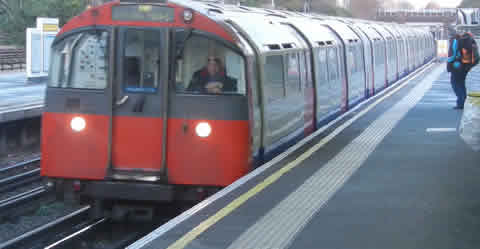
The London Underground comes out to Heathrow in the form of the Piccadilly Line. The big attraction is price, frequency and speed. It takes 45-60 minutes to reach most hotels in Central London with trains around every 5 minutes.
The downside is crowded carriages and stopping at around 20 stations on the way into London. There will be an Underground station near your ultimate destination after perhaps a change or two. Kings Cross to Heathrow and Victoria to Heathrow (with a change from the District Line) are two of the most common journeys taken, due to both of these being popular hotel areas in London.
Heathrow Airport is in Zone 6 of London's zoned transport system. To understand the zone system which is the basis for all fares on the London Underground, read our using the London Underground page. London's tube system is called the London Underground and not Metro London, as is common in some other Major cities.
The Underground carriages become grossly overcrowded during peak rush hours. Heathrow is the first stop so you will get a seat, however, getting off in central London with lots of luggage at peak times may be an experience you can do without after a long flight.
ON THIS HEATHROW TRANSFERS PAGE
» Heathrow stations & passenger terminals
» Train times & journey planning
» Changing trains from Piccadilly
» Tube journey times from Heathrow to Central London
» London Underground night service
» Taking luggage on the Underground
» Getting the best fares on Underground
» FAQs of Underground
» Heathrow public transport comparison table
» Map of Heathrow public transport
3 Heathrow Underground Stations, 4 Heathrow Passenger Terminals
Heathrow Airport has three Underground stations for the four passenger terminals. All trains visit the Heathrow Central Station that is for Terminals 2 and 3, some trains go to Terminal 4, the rest go to Terminal 5, no train visits both Terminal 4 and 5. When you are returning to Heathrow make sure you board the right train for your terminal.
Route 1 (Terminal 4) - Incoming trains from London will branch off after Hatton Cross station to Terminal 4. After Terminal 4 the train loops around to Central (Terminals 2,3) before going back to London. These trains do not go to Terminal 5 and do not travel the other way from Central to Heathrow Terminal 4.
Route 2 (Terminal 5) - Incoming trains from London will go straight to Central (Terminals 2,3) before going onto Terminal 5 where the train terminates. After a short while the train will return to London the same way. These trains do not visit Terminal 4.
London tube maps (PDF)
Underground map
Tube & rail map
Night tube map
Train Times & Journey Planning
From T2 & T3 the first train to Central London leaves Heathrow at around 5.12am (Sat/Sun 03:17). The last train leaves for Central London around 23:45 (Fri/Sat 03:07; Sun 23:28).
TFL Journey planner
From T4 the first train leaves around 05:02 (Sun 05:47). Last train leaves at around 23:35 (Sun 23:15). From T5 the first train leaves at around 05:23 (Sat/Sun 03:14) and last train leaves around 23:42 (Fri/Sat 03:04; Sun 23:25).
The first train from Central London (departing from Piccadilly Circus) arrives at Heathrow at around 05:47 (Sat/Sun 03:23) and the last train leaves for Heathrow from London around 00:32 (Fri/Sat 03:33; Sun 23:38). All times are subject to change and should be checked using the TFL journey planner link.
On Fridays and Saturday nights the Piccadilly Line runs all night at around 10 minute intervals between Terminal 5 and Cockfosters, stopping at Heathrow Central for Terminals 2 and 3. No trains run to Terminal 4 as part of the night service and if you are interconnecting to reach your destination, check that the other line also runs a night service (see Night Tube Map link within the sub-menu above).
When the Underground is shut there is a night bus alternative, route N9 which runs throughout the night at 30 minute intervals from Terminal 5 and also visiting the central bus station where Terminals 2 and 3 are. The route includes stops at Hammersmith, Knightsbridge, Hyde Park Corner and Piccadilly.

Changing trains from Piccadilly Line
Although the Piccadilly Line goes direct to many of London's major hotel districts a good proportion of travellers will need to change Underground train onto a different line. The most common change is to switch to one of the District Lines trains if you are going to Victoria, a major hotel district. If you look at the Underground Map, stations like Earls Court, South Kensington or Green Park initially look good places to switch.
In practice, these stations are not such a great idea if you are towing luggage as the distance between lines is significant and you will have to negotiate steps, escalators etc.
Hammersmith and Barons Court are better stations to switch train lines from as both lines use the same platform, you just walk off one train and the other train is about 8 yards in front of you. Even if you are taking the District Line branch down to the Bayswater/Paddington hotel area, it pays if you have luggage to change at both Barons Court and Earls Court, where trains depart from the same platform rather than battling the crowds and obstacles from the Piccadilly Line which is deep underground at this point, to the District Line on the surface.

Tube journey times from Heathrow to Central London stations
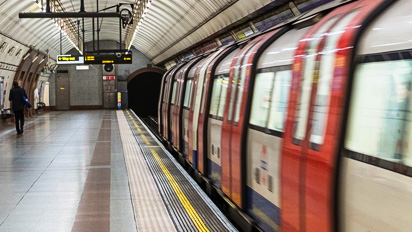
Heathrow to Earls Court: 35 mins
Heathrow to Gloucester Road: 36 mins
Heathrow to South Kensington: 38 mins
Heathrow to Knightsbridge: 40 mins
Heathrow to Hyde Park Corner: 42 mins
Heathrow to Green Park: 44 mins
Heathrow to Piccadilly Circus: 46 mins
Heathrow to Leicester Square: 47 mins
Heathrow to Covent Garden: 48 mins
Heathrow to Holborn: 50 mins
Heathrow to Russell Square: 52 mins
Heathrow to Kings Cross St Pancras: 54 mins
Heathrow to Victoria: 45 mins (one change to District Line)
Heathrow to Liverpool Street: 1hr 5 mins (one change to Central Line)
London Underground Night Service - The Night Tube
In 2016 the London Underground began to introduce a full 24/7 service on Friday and Saturday nights only. Introduction has been on a phased basis.
Night Tube services are now running on the Central, Victoria, Jubilee line, Northern line (Charing Cross branch) and Piccadilly line (but not Acton to Uxbridge branch). The Night Tube will offer a 24-hour service on Fridays and Saturdays. Standard off-peak fares are levied for travelling on the Night Tube using Oyster and Contactless cards.
Travelcards are valid from the first day of issue (using the date printed on the card), and for journeys starting before 4.30am the following day. For example, if you buy a 1 Day Travelcard at 11am on Friday, you can use it until 04:29 on the following Saturday.
Night Tube Map - Current Lines Operated
Taking luggage on Underground
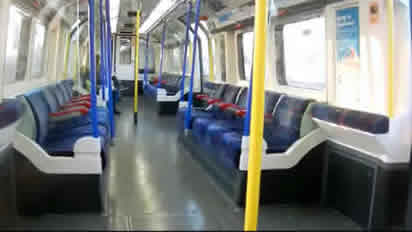
The London Underground system is bustling and crowded at all times of the day. This is not a problem normally, but is it practical to use the Underground with luggage in tow? Well the good news is yes it is fine, and many people do use the London Underground routinely with luggage.
The caveat is within reason, it's not such a good idea if you have arrived on a flight with a North American flight's luggage allowance. Up to one case of about 20 kg (44 lbs) should be fine. The main thing is to be prepared. It's not going to be a pleasant experience unless you're travelling early morning on a Saturday or Sunday, so just think of the money you are saving.
At Heathrow Airport, the Underground trains are near empty as they start at Heathrow, crowding is not going to be a problem at this point. You can do yourself a big favour by getting as far as possible away from other passengers with luggage on the platform before boarding. By the time you get to Hammersmith the probability is that people will be standing and the carriages are getting crowded.
So the trick is to put your luggage in the space by the door and sit in an empty seat next to it so you can keep an eye on it, (see images). Now you see the reason why you want to get as far from others with luggage on the platform. If the train gets really crowded a lot of people prefer to stand and sit or lean on their luggage.
Getting best fares on Underground
For the vast majority of people using the Underground purchasing a cash ticket on the day is very expensive compared with the alternatives everybody else will be using.
Yes, it can be complicated, especially if you have kids, but if you spend a little time understanding the basics you will be well rewarded financially by purchasing the appropriate ticket for you.
For the majority of visitors, an Oyster Card for each person will be the core of your transport needs within London. You can buy on-demand on arrival at Heathrow at the Underground Stations or you can buy in advance online a special Visitors Oyster Card.
The Oyster page linked below will enable you to budget likely costs, explains the advantages and disadvantages of standard Oysters v Visitor Oysters and potential money saving additions like Travelcards if you are staying more than 5 days and of course the hoops you need to negotiate if you have kids (under 16 years of age).
Oyster Card details
Frequently asked questions about the London Underground
Which tube line is Heathrow Terminal 5 on?
Heathrow Terminal 5 is on the Piccadilly line of the London Underground.
Between £3-6 depending on if you pay in cash or use Oyster, contactless card. See our pricing table above.
Can I use oyster card to Heathrow Airport?
Yes you can use your Oyster card to get to Heathrow, either on the tube or by using the Heathrow Express. The tube will include the journey in your daily cap, the Heathrow Express will not.
Does Heathrow have a tube?
Heathrow is on the Piccadilly line of the London Underground and has stations in Terminal 2 & 3, Terminal 4 and Terminal 5.

BUY VISITOR OYSTER CARD & TRAVELCARD FOR LONDON
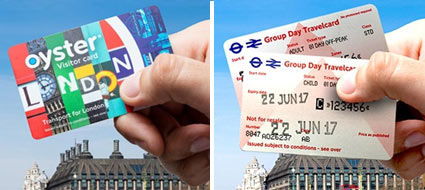
Visiting London? Save time and money on London public transport
• Visitor Oyster Card • Travelcard for 1 day anytime / off-peak or 7 days anytime • Group day travelcards available
London - Heathrow comparison of public transport from 3 March 2024 - March 2025
* Standard adult ticket. Other promotional fares may appear from time to time.
Heathrow Express train - Children under 15 free, online only one-way fare. Cheapest fare for both weekday and weekend travel.
Cheapest Heathrow Express fares are only available 90 days or over in advance and only using the mobile app.
Where Heathrow public transport goes in central London
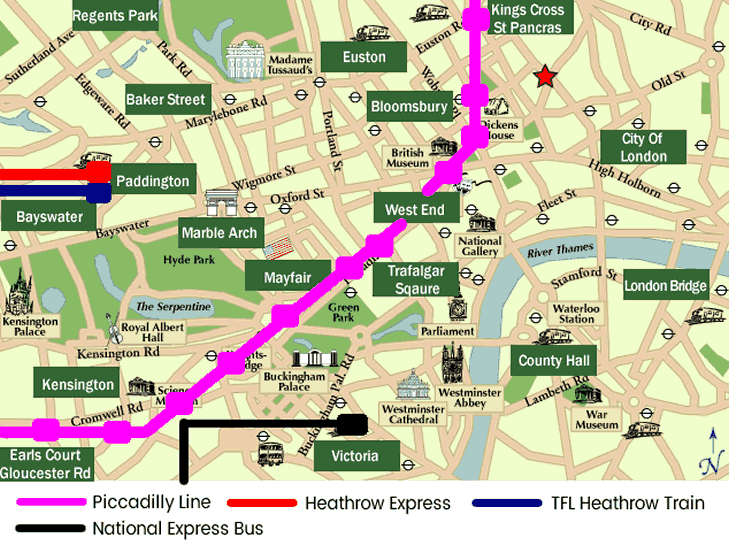
LONDON TUBE MAPS (PDF)
Heathrow to/from london, tours from heathrow, airport to airport, cruise port transfers, to the rest of the uk, heathrow hotels, hotel to terminal, heathrow hotel areas, heathrow parking.

Map of the Piccadilly Line
Welcome to the official site for the London Piccadilly Line maps. This iconic dark blue line serves as a vital link between West and North London. Notably, in the west, it features two branches that converge at Acton Town station.
The Piccadilly Line also boasts stations at Heathrow International Airport, offering the quickest transit option to Central London. Additionally, it passes near another key London landmark – Buckingham Palace. For visiting the Palace, alight at Hyde Park Corner station.
List of Piccadilly Line maps
See the stations on the map below (April 2024).
→ Click map to zoom ←
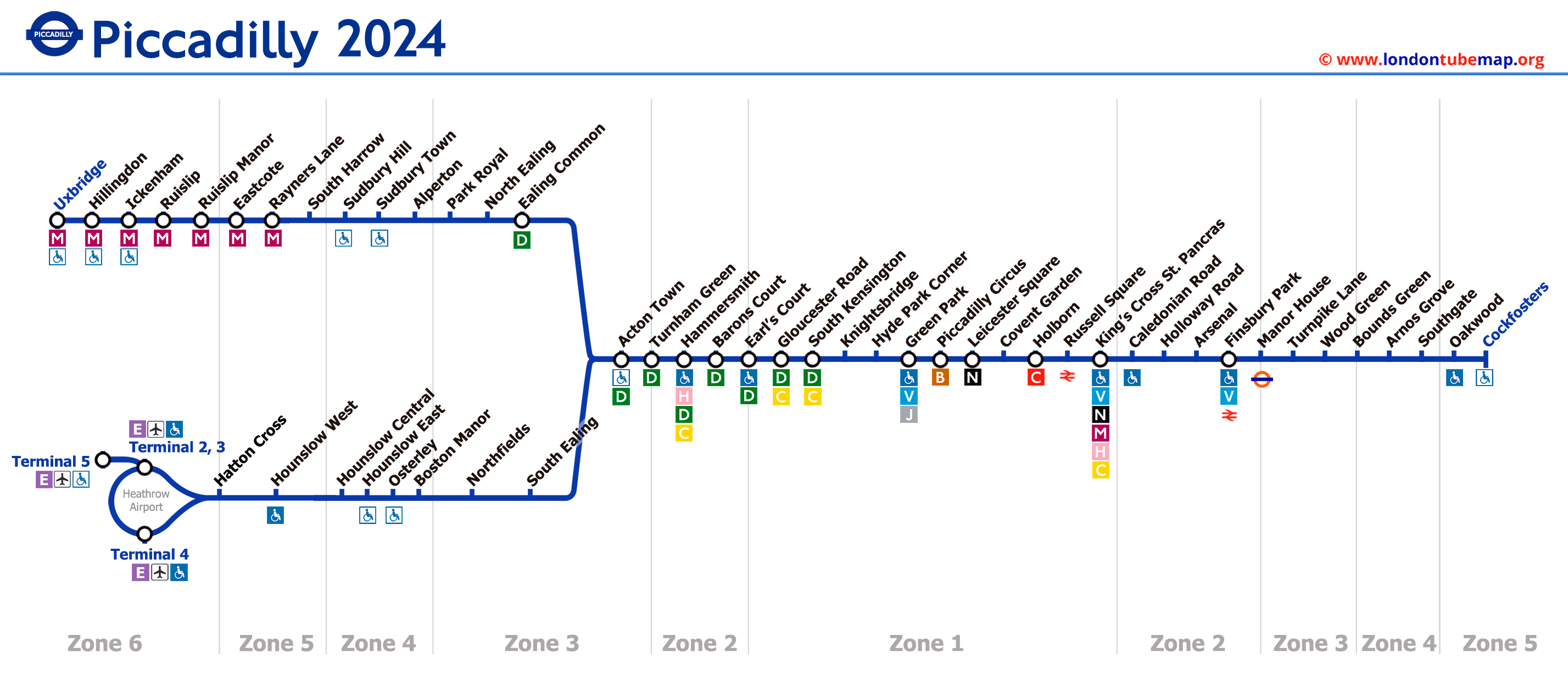
Overview of this tube line:
- Opened in 1906.
- Colour: Dark blue.
- Underground.
- 53 stations.
- 71 km (44 miles) long.
Should you wish to explore the entirety of the London Underground network, you are invited to view the comprehensive London Tube map . This resource includes a page where all lines are neatly presented together (yet distinctly separate) , or you may opt to examine individual lines simultaneously.
Airport Routes
Travelling between terminals at Heathrow Airport using the Piccadilly Line might seem a bit daunting, so here's a simplified table summarizing the connections between terminals using the Piccadilly Line. All these inter-terminal journeys at Heathrow Airport are free with an Oyster card or contactless payment.
Piccadilly line stations and routes
The Piccadilly line currently has 3 different routes, so before boarding, it is important to look carefully at the front of the train and check the sign with the name of the destination to avoid getting onto the wrong Tube train.
If you click on the name of the station, you can see real-time timetable information and more detailed info. If you click on the line icons, you will see information about that line and its transfers.
Route 1: Heathrow Terminal 4 - Cockfosters
Reverse route view

Route 2: Heathrow Terminal 5 - Cockfosters
Route 3: uxbridge - cockfosters.
London tube map | Timetable | Fares | All subway lines
This website uses cookies to improve your browsing experience and analyze the use of the website. Learn More

How to Use the London Tube (Subway)

This post is a quick and easy tutorial on how to navigate the London Underground (a.k.a. the Tube), including hours of operation as well as info on Oyster Cards, transfers, and other helpful tips.
- What is the London Underground?
- Tickets, Fares, and Oyster Cards
- The Tube Map
- Operating Hours
- Tips from Locals
- to/from Heathrow Airport
- Tourist Buses vs. the Tube
WHAT IS THE LONDON UNDERGROUND?
Similar to the New York Subway or the Paris Metro, the London Underground is London's series of (largely) underground trains that run a regular service throughout the city.
Since the trains underground run through a series of tunnels, many people (Londoners and visitors alike!) refer to it as the "tube."
Despite this name, a lot of the London Underground network is above ground when you travel, particularly outside of central London.

The London Underground has 11 lines that serve Greater London, intersecting with each other in the centre of town.
The tube map is divided into nine zones, with Zone 1 being the centre of London, and Zone 9 being the suburbs.
The cost it takes to travel depends on which zone(s) you travel in, and how far your journey will take you.
It also connects to the London Overground (a suburban train line that doesn't run through the centre of town), the new Elizabeth Line (a high-frequency rail service that covers both central London, Heathrow Airport, and the suburbs), and National Rail Services (standard train lines that run throughout the country).
The Underground also connects to other rail services that serve the capital such as the Docklands Light Railway (an aboveground small train line that serves the docklands area).
WHEN DOES THE UNDERGROUND RUN?
In general, the Underground trains run from around 5:00 - 5:30 am until the last train leaves around Midnight, (exact times will vary and are listed on the Transport for London website ).
However, there are Night Tube services that run on some of the lines on Fridays and Saturdays for convenient travel on the weekends.
The Night Tube runs on parts of the Central, Jubilee, Northern, Piccadilly, and Victoria lines only.
LONDON UNDERGROUND TICKETS AND OYSTER CARDS
Buying a ticket for the London Underground is pretty straightforward, but for most visitors, using a contactless payment card is the best payment method.
So, for a more in-depth explanation, including the cheapest ways to travel, check out our previous post about ticket prices and options here in London. Below is our summary.
There are 4 ways to pay for your rides on the Tube:
- Paper tickets
- Oyster Cards
- Contactless Credit/Debit Cards
We normally recommend avoiding paper tickets and recommend that you buy yourself an Oyster card, unless you have a contactless credit or debit card.
Rides with an Oyster Card or contactless card are much cheaper than paper tickets.
You can add as much money to these as you wish and there is a daily limit that you will spend, (£8.10 for Zones 1-2) so the rides get cheaper the more you use them. The same daily cap applies to your contactless card, too.
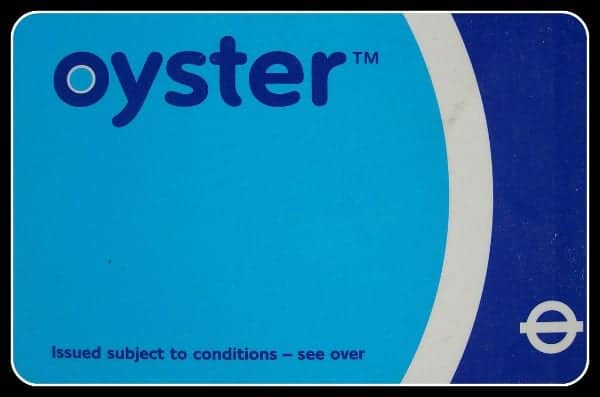
Read our post on which London Oyster Card or Travelcard to buy .
TIP: The Oyster Card is actually included with the London Turbo Pass at no extra cost. If you're planning to visit several notable attractions in the city, this could be a great way to save some money.
London Underground Fares
While there are 6 travel zones for the London Underground, most visitors to London will travel largely within Zones 1 + 2.
How much you pay depends on when you travel, whether during peak hours (06:30 - 09:30 and 16:00 - 19:00 Mon-Fri) vs. off-peak (all other times).
It also depends on where you travel to and from, and whether you are using a paper ticket vs. an Oyster, Travelcard, or contactless credit/debit card.
If you have one of the latter, then you will pay somewhere between £2.70 and £3.00 per ride within Zones 1 + 2.
The most expensive ride (Central London to Heathrow) will cost either £3.30 (off-peak) or £5.60 (peak).
Oyster and Travelcards can be used on all of London's public transportation options, including buses, DLR, the Overground, suburban trains (within London), a water taxi, and even a gondola.
Daily Limits
If you use an Oyster Card or a Contactless Card, then there are daily limits to what you will spend. These caps are dependent on where you are traveling within.
So, for example, if you stay within Zones 1 and 2, the cap for an adult is just £8.10 for the Underground and £5.25 for buses.
So, the more you ride, the cheaper each ride is. You can see what the cap is for each zone or between zones here.
Child Offers
Children under 11 travel for free and there is a 50% off on Oyster Card fares for children 11-15 years of age.
To receive this offer, you need to grab a Tube staff member at any Underground station, including Heathrow.
We help you determine which type of card or ticket you need in our in-depth post on Oyster Cards .
Travelcards
Travelcards are prepaid cards that give you unlimited access to specific zones within London.
You can choose to either order these in advance (in which case you will be given a paper Travelcard) or you can buy them upon arrival (in which case you will be using a plastic Oyster Card with the Travel Card loaded onto it).
Travelcards particularly have benefits for travellers here for an entire week. A 7-Day Travelcard can be worth your while, as a 7-Day Travelcard for Zones 1-2 is £40.70 which works out less per day than the £8.10 daily cap.
Find out more on our post comparing Oyster Cards, Visitor Oyster Cards and Travelcards .
UNDERSTANDING THE TUBE MAP
Picking up a Tube map is easy! They are available for free at most stations on the Underground network.
The maps on offer at the stations are small – perfect for carrying around in your pocket.
Below is a map of the London Underground. You could also download a PDF version .

Don’t be embarrassed to consult your map as you travel through London, even Londoners themselves occasionally need to check where it is they are heading to!
Some people will actually have an app on their phone sporting the London Underground tube map – though we think Google Maps App is very good.
If you look closely at the map, you will notice that the center part is shaded white (zone 1) with a ring of gray shade (zone 2) which is also surrounded by white again (zone 3).
Again, most visitors to London will spend much, if not all, of their time in Zones 1-2.
Focus on Colours
Every line on the London Underground has a different name and colour.
The names and colours will appear on your Tube Map, and also all over the various stations on the network.
For some, memorising the names is easier, but in general, colours can be the simplest way to learn your way around, and also to use when asking for/receiving directions.
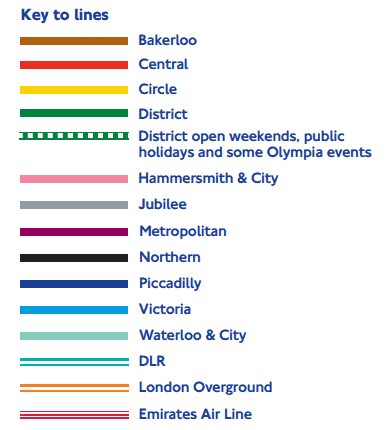
Generally speaking, any particular line will either head north-south or east-west.
FREE TOURS BY FOOT TIP:
Start your holiday in London with our All-in-One London Tour, which takes in most of London's legendary tourist sites and utilizes the London Underground. Get a tutorial directly from us.
OPERATING HOURS AND THE NIGHT TUBE
It’s important to remember that the London Underground system doesn’t run 24 hours a day every day and that timings may be different on weekdays vs. weekends.
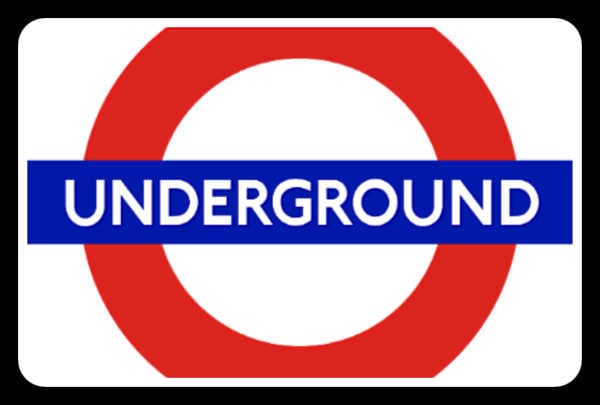
General Hours
Although each station has different timings, in general, the first tube trains start running around 5:00 am - 5:15 am and finish around 12:00 am - 12:30 am from Mondays through Fridays.
On Sundays, the Tube begins a bit later, around 6:00 am - 6:15 am and the final trains depart around 11:30 pm - 12:30 am.
Sundays also carry a reduced service which means there are not as many trains running as on Mondays to Saturdays.
Weekdays: 7:00 am - 9:30 am and 16:00 (4 pm) - 19:00 (7 pm).
Like any major city, London has a very busy rush hour in the mornings and in the evenings when the majority of people are travelling to and from work.
If possible, try to avoid travelling on the tube during these times, particularly if you have any large baggage/luggage with you.
Space is an absolute premium, which means you may have to wait as multiple trains pass you until there’s one with enough space to fit you in.
If you need a place to store luggage, read our advice here.
The Night Tube
As of 2019, some London Underground lines are now operating as The Night Tube, a 24-hour Underground service that operates on Fridays and Saturdays.
Really, this service should be called the "Overnight Tube" as the regular operating hours reach midnight every day of the week.
Click here for a downloadable pdf .

There are 5 lines making up the Night Tube and there are fewer trains operating, which means wait times are more than the standard 2 - 5 minutes.
The lines and approximate timings are:
- Victoria Line - Trains every 10 minutes
- Jubilee Line - Trains every 10 minutes
- Piccadilly Line (Cockfosters to Heathrow Terminal 5 ONLY) - Trains every 10 minutes
- Northern Line (Camden Town to Morden) - Trains every 8 minutes
- Northern Line (Camden Town to High Barnet) - Trains every 15 minutes (No Night Tube on the Bank and Mill Hill East Branches)
- Central Line (White City to Leytonstone) - Trains every 10 minutes
- Central Line (Leytonstone to Loughton/Hainault) - Trains every 20 minutes
- Central Line (Ealing Broadway to White City) - Trains every 20 minutes (No Night Tube on other branches of the line)
NOTE: The Night Tube operates with standard off-peak fare prices. Your daily travel card will be valid until 4:29 am the morning after you have purchased it.
TIPS ON NAVIGATING THE UNDERGROUND
Now we will provide you with our top 7 tips for navigating your way through the system, from how to enter a system, how to board the correct train, how to change lines, and when to walk instead of taking the Tube.
Underground Tutorial Tours
Let us, Free Tours by Foot , show you how to utilize the London Underground to get around the city - like our London in a Day or our Harry Potter Tour .

While these are not specifically Underground tours, your tour guide will assist you in learning how to master the system and to offer you some tips and tricks for riding the Tube.
1. Entering and Exiting Stations
All Underground stations have ticket barriers – large grey machines where travellers either insert their paper travel cards or tap their Oyster cards on top of them.
At first glance, most barriers all seem the same but they are actually divided into three different purposes; Enter, Do Not Enter, Bags/Buggies.

Some of the barriers will have a green arrow displayed – this means this is a barrier that you can travel through.
Insert your paper ticket, or tap your Oystercard on the yellow pad right next to the sign displaying the green arrow.
The barriers in front of you (just left from the arrow) will open and allow you to walk through.
Other barriers will have a red X displayed – this means this barrier will not open for you and is either closed or being used for visitors traveling in the opposite direction.
Lastly, some barriers are quite large, with signs displaying buggies, luggage, and wheelchairs.
These barriers are much larger than the regular grey ones and are there for people travelling with added items/persons.
They will not close as quickly as the others, giving travellers time to get themselves and all possessions through to the other side.
Read our post on taking the Tube from Heathrow Airport to Central London .
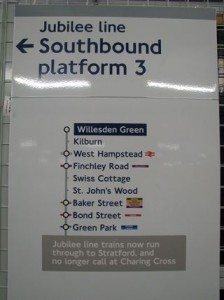
2. Find Your Correct Direction
In general, the Underground lines operate going north-south or east-west and vice versa.
Checking on your map will help you determine which direction you are travelling in, which will help you find the correct platform and train for your journey.
At every station, there will be maps like these showing the two directions that the trains will be travelling in, and under each direction will be a list of all the stations the train will stop at – in order!
This makes it easy not only to see which platform you need to be on but also how many stops it will take you to get to your destination.
3. Don't Board the Wrong Train
Sometimes, multiple Underground lines share the same track at a station. If you aren't paying attention, you could board the wrong train.
As the trains pull into the platform, you can take a glance at the front of the train. Here will be displayed the final destination of that particular train.
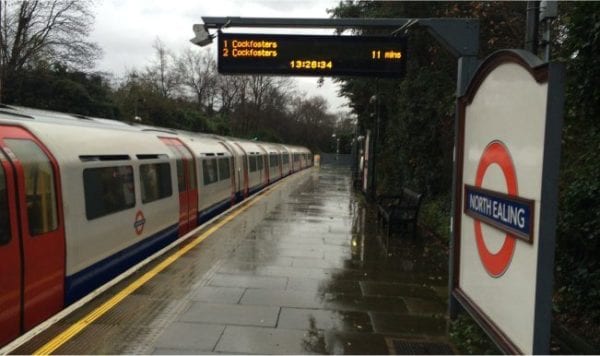
Also, on every platform there will be an electronic sign displaying the time until the next train arrives, and which station will be its’ final stop.
4. Lines that Split
Another potential mixup is lines that split. Some lines can have 2 or 3 different ending tracks, so you need to be aware of this.
Take the image below as an example.
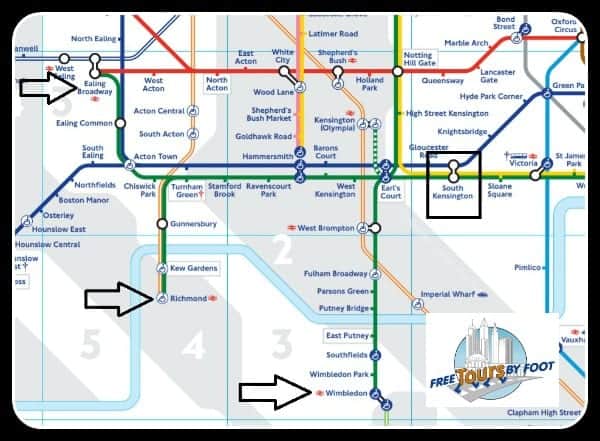
For example, suppose you plan on boarding a District Line (green) train at South Kensington Station (the black square) with a final destination Wimbledon (the bottom-most black arrow).
You would be taking a westbound train.
However, you can see from the map that there are two additional tracks with different ending points (Richmond and Ealing Broadway), all a part of the District Line heading westbound.
As you probably can tell, you could end up missing the first tennis match.
5. Changing Lines
The Tube map can often be misleading in that many tube lines crisscross over each other on the map, but do not actually connect to one another in reality.
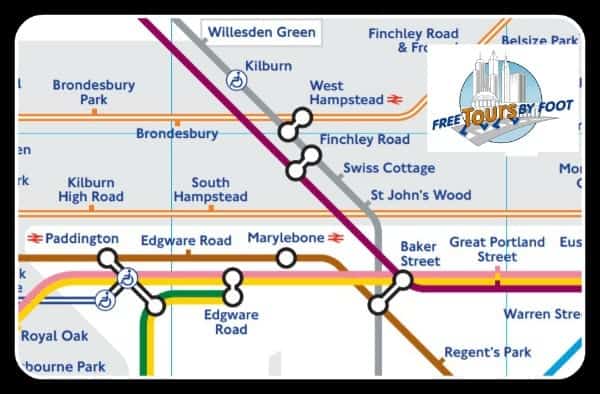
If you want to know where you can change from one Tube line to the other, you need to look for the white circle on the line on your map.
Any time you see one of these, it means you can change from one line to another or to British Rail.
Check out our tips on using the Underground with luggage and kids .
6. Sometimes You Should Just Walk
The London Underground Map is definitely NOT geographically accurate. Oftentimes it is easier to walk instead of getting on the tube to travel just a stop or two.
There is a map that gives the walking times between stations ( pdf ).
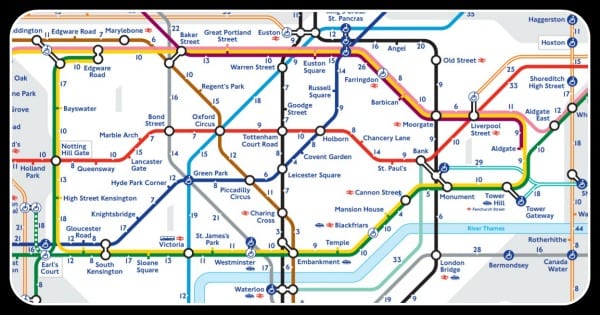
A good example of this is Leicester Square and Covent Garden on the Piccadilly Line.
On the map, they appear a fair distance apart, but in reality, it would take you just 4 minutes to walk the journey yourself.
Another good example is Charing Cross and Embankment - it’s just a 2-minute walk from each station!
7. Step-Free (Handicap) Access
For those with limited mobility, there are clues on the Underground map that will let you know if there is step-free access.
This is also useful if you are travelling with exceptionally heavy suitcases.
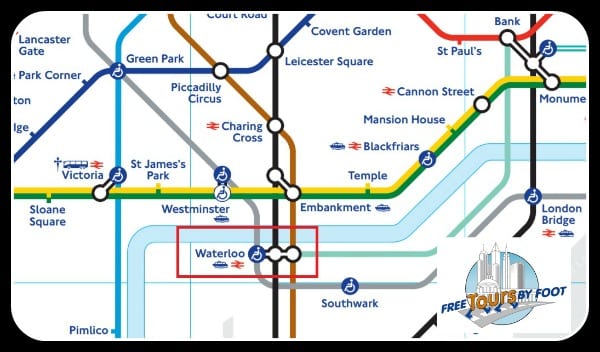
Simply look at the map, and on some stations, you will see a blue circle with a white figure in a wheelchair.
This means it is possible to get from the street into the train without any stairs or escalators.

The white circle and a blue figure in a wheelchair denote stations with step-free access from the street to the platform.
At these stations, you will need assistance to get into and out of the train, either with a ramp or the help of fellow passengers.
Note that in larger stations, such as Waterloo, the blue circle appears on one line only, which means the other two lines do not have step-free access. Transport for London has this helpful video .
A final note – Although London is generally a safe and welcoming city for visitors, pickpockets, and thieves operate throughout the entire London Underground network.
Please be aware of your surroundings, keep hold of all of your possessions, and avoid the habit of simply putting your ticket/credit cards/keys/mobile phones into your pockets – this will make you an incredibly easy target!
Also, never leave your belongings unattended on a train or in an Underground Station.
PICADILLY LINE TO AND FROM HEATHROW
By far the easiest and most affordable way to get to and from Heathrow Airport.
The Piccadilly Line runs through all 5 terminals of Heathrow Airport as well as straight through the centre of London, offering connections with every other tube line on the London Underground network.
Use our Google Map and input the address of your final destination for directions and travel time from Heathrow .
Travel time on the Tube is roughly 45 minutes to central London.
Piccadilly line trains run out of Heathrow from 5:00 to 23:00.
Ticket prices from Zone 1 to Heathrow are £6.70 for a cash-bought paper ticket, £5.60 on an Oyster card or contactless card at any time.
Read our full post on taking the Picadilly Line to and from Heathrow Airport .
TUBE ETIQUETTE
To avoid faux pas and keep from being marked out as a typical tourist, here are a few tips for Tube etiquette when travelling along the Tube.

1. Have Your Ticket Ready
Do not approach the ticket barriers until you have your Oystercard – or paper ticket – ready.
If you walk to the barrier and then fumble through your pockets/bags for your ticket, it will delay other travellers and oftentimes can mess with the barrier censors, potentially causing the barriers to lock.
[Remember you need a ticket both to BEGIN/ENTER and also to FINISH/LEAVE your journey!] Be sure to read our blog post on the Oystercard and Travel Card .
2. Stand on the Right
When riding escalators up and down in Underground Stations, please remember to stand on the RIGHT.
Travellers who wish to move up/down whilst on the escalators will be doing so on the left-hand side.
If you stand on the left you may find yourself politely asked to move to the right, or simply shoved past by a multitude of commuters.
This also includes your belongings/suitcases – they must be on the right of the escalators as well.
It is poor form and bad manners to take up the left side of the escalator with your belongings.
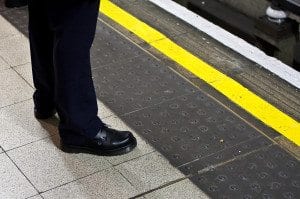
3. Stand Behind the Yellow Line
On every Tube platform, you will find a yellow line painted along the edge.
This line marks the boundary between where it is safe to stand, and where it is dangerous.
Stand BEHIND the line (not on top of!) in order to limit any risk of death or injury.
You may occasionally see passengers swiftly walking down the platform directly on top of the yellow line – but do not follow their lead!
4. Move Down the Platform
As soon as you get onto the platform, move either right or left.
You will find many people gathered at the entrance to the platform, meaning people cannot get past them and move onto the platform to get their train.
TIP : Besides just being courteous, the rear and front of the trains tend to be less crowded so moving down the platform means you’re more likely to get a seat!

5. Let Other Passengers Off First
As soon as the Tube doors open, step to either side of the opening doors and let customers off the train before you attempt to board.
Failure to follow this rule may lead to verbal chastisement.
6. Move Down Inside the Carriage
Once you are inside the Tube – move away from the door! Standing in place will impede others who are trying to board.
Also (especially during peak times) it is important to move as far down into the carriage as possible in order for the maximum amount of people to fit onto the train.
You will see Londoners standing in between the benches on busy Tube carriages, and you should follow their lead.
7. Keep Feet and Bags Off the Seats
Particularly on crowded trains, it is unacceptable to take up an entire seat solely for your possessions – or your feet!
8. Do Not Lean on the Poles
The poles that are placed throughout the Underground train carriages are meant for people to hold on to.
Leaning against one of the poles means blocking the pole for those that may need it to hold balance whilst the train is moving.
9. Mind Your Earphones and Your Meals
The music you are listening to should not be loud enough for anybody else on the Tube to hear.
Also, it is best to avoid eating hot/smelly food on the Underground.
10. Get Out of the Way of Those Getting Off the Train
When you are on the Tube and at a stop that is not yours, make sure you are not in the way of those who are trying to exit the train.
Occasionally, you may need to step outside of the train to let passengers off if the carriage is very crowded.
This is expected behaviour, and you will be able to step right back on once the departing have left.
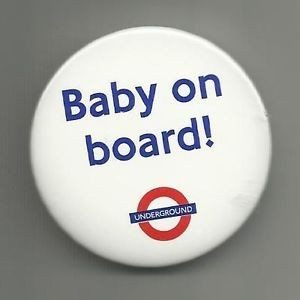
11. Stand Up for the Elderly and Pregnant
This is one even some Underground regulars need reminding of!
It’s just good manners in the UK to offer up your seat to the elderly, pregnant, or those who are less able to stand.
Be aware of who comes on the Tube at each stop and do not be afraid to offer your seat.
Occasionally you may see women with a small ‘Baby on Board’ badge with the London Underground logo pinned onto their coats.
Some men even take it upon themselves to stand up for any woman who comes onto the train so chivalry is not completely dead in London!
12. Take Your Rubbish Home With You
Rubbish left behind on the Tube is unsightly and can be quite disgusting.
There are no bins on Underground trains or at most Underground Stations which means it is expected that you will take any rubbish of yours off the train and home/back to your hotel with you when you leave.
On the London Underground, a little bit of courtesy and kindness can go a long way.
Commuting and travelling in the city can be quite stressful so try to remain courteous to others as you go about their business, and hopefully, they will do the same as you go about yours
HOP-ON-HOP-OFF BUS VS. LONDON UNDERGROUND
If you’re visiting London and aren’t sure about riding the London Underground, then we hope our tips above have made you more confident and willing to use the tube to get around town.
However, we understand that some people may still be a little anxious or unsure about the benefits of taking the tube, as opposed to riding one of London’s hop-on-hop-off tour buses.
To help you make up your mind, we’ve listed a few pros and cons of each below.

Hop-on-hop-off buses can be useful in getting an overview of the city or learning your way around town.
They are also quite useful for people who aren’t physically fit enough to walk through London day in and day out.
However, whenever possible, we strongly believe that the best - and the quickest - way to get around town is by taking the London Underground or to walk.
[Note that if you wish to take a hop-on-hop-off bus tour, we have a handy page HERE to help you choose which one to ride]
Pros of a Bus Tour
- easy to understand routes
- convenient stops at the most popular tourist attractions
- climate controlled all year (on the inside)
- tickets often include night tours, boat cruises, or free attractions.
- commentary along the routes
Cons of a Bus Tour
- more expensive than riding the subway
- routes are only one-direction
- wait times can be very long due to seasonal or even daily traffic
- buses can be crowded
- bad weather is always a risk
Pros of Riding the Underground
- (relatively) inexpensive
- flexible routing
- very warm in the winter
- you get to travel like a real Londoner
- Almost always faster than a bus
Cons of Riding the Underground
- not all stations are accessible for wheelchairs and strollers
- can be really hot and sweaty in summer
- can be really crowded during rush hours
- no commentary
Related Content
- Which Oystercard to Buy
- How to Get from Heathrow to London Centre by Underground
- How to Get from London to Paris by Train
- Things to do in London
- Most Haunted Places in London
Choose a Destination... I want them all PLUS general travel tips. Amsterdam Berlin Boston Charleston Chicago Dubai Lisbon London Los Angeles Miami Nashville New York City New Orleans Paris Philadelphia Prague Rome San Francisco Washington DC
About The Author

North America
United kingdom & ireland, middle east & india, asia & oceania.
Piccadilly Line - current status, departures & statistics

Piccadilly Circus station - Train Times, Tube Fares & Stairs
Piccadilly Circus underground station has 4 platforms. It is in Oyster fare zone 1 and connects with the Bakerloo and Piccadilly underground lines
London Underground delays at Piccadilly Circus station
Next train from piccadilly circus station.
Tube line closures on the Bakerloo and Piccadilly line
Underground train fares from Piccadilly Circus
Piccadilly Circus station is in zone 1 (central London)
Peak and off-peak journey times
For Oyster and contactless off-peak is outside the hours of 6.30 AM-9.30 AM and 4 PM-7 PM (Mon-Fri). For travelcards off-peak is any time after 9.30 AM (Mon-Fri). Weekends and public holidays are always classed as off-peak. Note: Between the 8th March and 31st May 2024 TFL are running a trial called ‘Off-Peak Friday Fares’, where Fridays will be classed as off-peak all day.
The tube fare is based on what time your journey begins. It doesn’t matter what time your journey ends.
Platform stairs, lifts and escalators at Piccadilly Circus
Piccadilly Circus tube station is not wheelchair accessible
Station entrance – You must use two flights of stairs between the entrances and the booking hall (19 steps down +4 steps down from the Piccadilly northside entrance, 19 steps down +9 steps down from the Regent Street southside entrance, 22 steps down +8 steps down from the Glasshouse Street entrance, 2x13 steps down from the Coventry Street entrance, and 2x12 steps down from the Lower Regent Street entrance). After that there are two escalators plus another flight of stairs to the platforms (19 steps down to the Piccadilly platforms, and 20 steps down to the Bakerloo platforms)
Station exit – There are two escalators plus a flight of stairs from the platforms to the booking hall (19 steps up from the Piccadilly platforms, and 20 steps up from the Bakerloo platforms). After that you must use another two flights of stairs to the exit (4 steps up +19 steps up to the Piccadilly northside exit, 9 steps up +19 steps up to the Regent Street southside exit, 8 steps up +22 steps up to the Glasshouse Street exit, 2x13 steps up to the Coventry Street exit, and 2x12 steps up to the Lower Regent Street exit)
Changing train platforms – You must use stairs when changing between the Bakerloo/Piccadilly line platforms (19 steps up +20 steps down)
Tube journey planner – Timetables, First & Last Train Times
Look up timetables and first and last train times from Piccadilly Circus to Bank , Charing Cross , Earl’s Court , Euston , King’s Cross , Liverpool Street , London Bridge , Marylebone , Paddington , Victoria , Waterloo or another train station:
Other underground stations that are close to Piccadilly Circus include Leicester Square , Green Park and Charing Cross train station
Piccadilly Circus underground station facilities
Your comments and questions.
Be the first to talk about this station
You must enable javascript to leave a comment
Forum: London Buses, Taxis & Trains

Route Planner
Alternative Route
Station information, marylebone to piccadilly circus, * estimated journey time:.

Live Departure Boards
* Journey times are calculated using average scheduled times between stations. 5 minutes are added for each connecting service. Actual times may of course differ. Some services do not operate at certain times of the day or week.
Cookie Consent
A1 Publishing Ltd and our advertising partners would like the opportunity of serving you with personalised ads. In order to do so we need your consent. By giving consent we may set various cookies in order to identify you and or your traits thus allowing us to provide more relevant advertising. Otherwise you will be presented with contextual or random ads only and no personal data will be saved.

IMAGES
VIDEO
COMMENTS
Check the timetable for Piccadilly line in London and plan your journey on the Underground network.
Piccadilly line timetable ... Select time range: A service will Depart 06:19. and Arrive ... Journeys Plan a journey and favourite it for quick access in the future. Places Choose postcodes, stations and places for quick journey planning. Close edit Favourites Favourite lines.
Connects to Circle, Hammersmith & City, Metropolitan, Northern and Victoria Connects to National Rail. Caledonian Road Underground Station. Holloway Road Underground Station. Arsenal Underground Station. Finsbury Park Underground Station. Connects to Victoria Connects to National Rail.
Journey times on the Piccadilly line are usually around an hour and a half. Train dwell times are slightly longer at some stations, such as at Heathrow Terminals 4 and 5 stations. The former requires 8 minutes, while the latter needs 7 minutes to coordinate with the alternate Heathrow service schedule. The busiest section, as of 2016, is ...
TfL fares frozen until March 2025. Find out more about fares. Plan your journey across the TfL network. Journey planner for Bus, Tube, London Overground, DLR, Elizabeth line, National Rail, Tram, River Bus, IFS Cloud Cable Car, Coach.
1:32. Heathrow T123. 1:33. Heathrow T5. 1:36. London Underground Piccadilly line. Route and times to stations Eastbound and Westbound. Real-time line status information.
The Piccadilly Line is a line of the London Underground network which crosses the town of London from the north to the west. It connects the Heathrow Airport and the town of Uxbridge in the western part of the Greater London to Cockfosters, in the north, through the city centre of the English capital city. Around 220,000,000 passengers use the ...
The TfL Piccadilly - Piccadilly underground serves 56 underground stops in the London area departing from Heathrow Terminal 5 and ending at Ravenscourt Park. Scroll down to see upcoming Piccadilly underground times at each stop and the next scheduled Piccadilly underground times will be displayed. The full Piccadilly underground schedule as ...
Piccadilly Line Tube Map. This is a single line tube map for the Piccadilly Line on the London Underground. All stations are listed, all zones are displayed. Interchange lines and journey times between each stop are also shown. Click on the Piccadilly Line Map to make it bigger.
VIEW LINE SCHEDULE PICCADILLY tube Time Schedule Uxbridge - Cockfosters Route Timetable: Sunday. 12:05 AM - 10:44 PM. Monday 12:01 AM - 11:44 PM: ... PICCADILLY tube time schedules and route maps are available in an of fline. PDF at moovitapp.com. Use the . Moovit App to see live bus times, train
London Underground PICCADILLY tube Route Schedule and Stops (Updated) The PICCADILLY tube (Uxbridge - Cockfosters) has 37 stations departing from Uxbridge and ending at Wood Green. ... Line PICCADILLY Real Time Tube Tracker. Track line PICCADILLY (Uxbridge - Cockfosters) on a live map in real time and follow its location as it moves between ...
Piccadilly line timetable. From: Piccadilly Circus Underground Station. To: Heathrow Terminals 1-2-3 Underground Station. Edit. Depart 08:07. Arrive 08:55. to Heathrow Terminal 5 Underground Station Heathrow Terminals 1-2-3 Underground Station. Depart 08:17.
The London Underground comes out to Heathrow in the form of the Piccadilly Line. The big attraction is price, frequency and speed. It takes 45-60 minutes to reach most hotels in Central London with trains around every 5 minutes. ... Train Times & Journey Planning. From T2 & T3 the first train to Central London leaves Heathrow at around 5.12am ...
Updated: April 2024. Welcome to the official site for the London Piccadilly Line maps. This iconic dark blue line serves as a vital link between West and North London. Notably, in the west, it features two branches that converge at Acton Town station. The Piccadilly Line also boasts stations at Heathrow International Airport, offering the ...
Info about Holborn underground station in Zone 1 on the Central and Piccadilly line with tube fares, platform stairs, escalators, lifts and train times. ... Peak and off-peak journey times. For Oyster and contactless off-peak is outside the hours of 6.30 AM-9.30 AM and 4 PM-7 PM (Mon-Fri).
Travel time on the Tube is roughly 45 minutes to central London. Piccadilly line trains run out of Heathrow from 5:00 to 23:00. Ticket prices from Zone 1 to Heathrow are £6.70 for a cash-bought paper ticket, £5.60 on an Oyster card or contactless card at any time.
50.85. Apr 2024. 67.68. Current status of the Piccadilly Line. View live departures and statistics for the Piccadilly Line.
Timetable for Piccadilly line in London. Please select a Piccadilly line start and end point.
Info about Piccadilly Circus underground station on the Bakerloo and Piccadilly line with Zone 1 tube fares, platform stairs, lifts and train times. ... Peak and off-peak journey times. For Oyster and contactless off-peak is outside the hours of 6.30 AM-9.30 AM and 4 PM-7 PM (Mon-Fri).
Plan a rail journey in the UK or Europe with our Journey Planner. Our Journey Planner will show you all the available options to get you from A to B. Enter your departure and arrival stations and our clever tool will show you all the relevant info, including: Train times. Direct and indirect services. Changes.
Elephant and Castle. 0:30. Elephant and Castle. 2:00. Elephant and Castle. 4:00. * Journey times are calculated using average scheduled times between stations. 5 minutes are added for each connecting service. Actual times may of course differ. Some services do not operate at certain times of the day or week.
Select time range: A service will Depart 05:02. and Arrive 06:35 ... Piccadilly Line: Minor delays between Acton Town, Heathrow Airport and Uxbridge due to train cancellations. GOOD SERVICE on the rest of the line. ... Journeys Plan a journey and favourite it for quick access in the future. Places Choose postcodes, ...
The cheapest way to get from Piccadilly to Euston Station is to line 390 bus via Euston Square which costs £1 - £3 and takes 40 min. More details ... Rome2Rio displays up to date schedules, route maps, journey times and estimated fares from relevant transport operators, ensuring you can make an informed decision about which option will suit ...